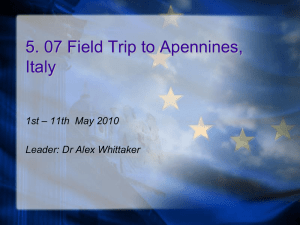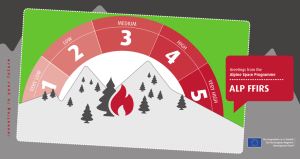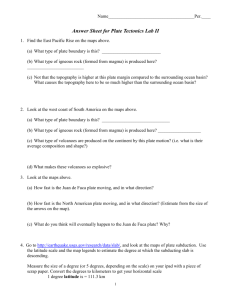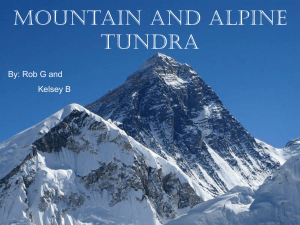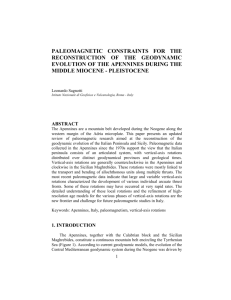Text formatting for Rendiconti online della Società Geologica Italiana
advertisement
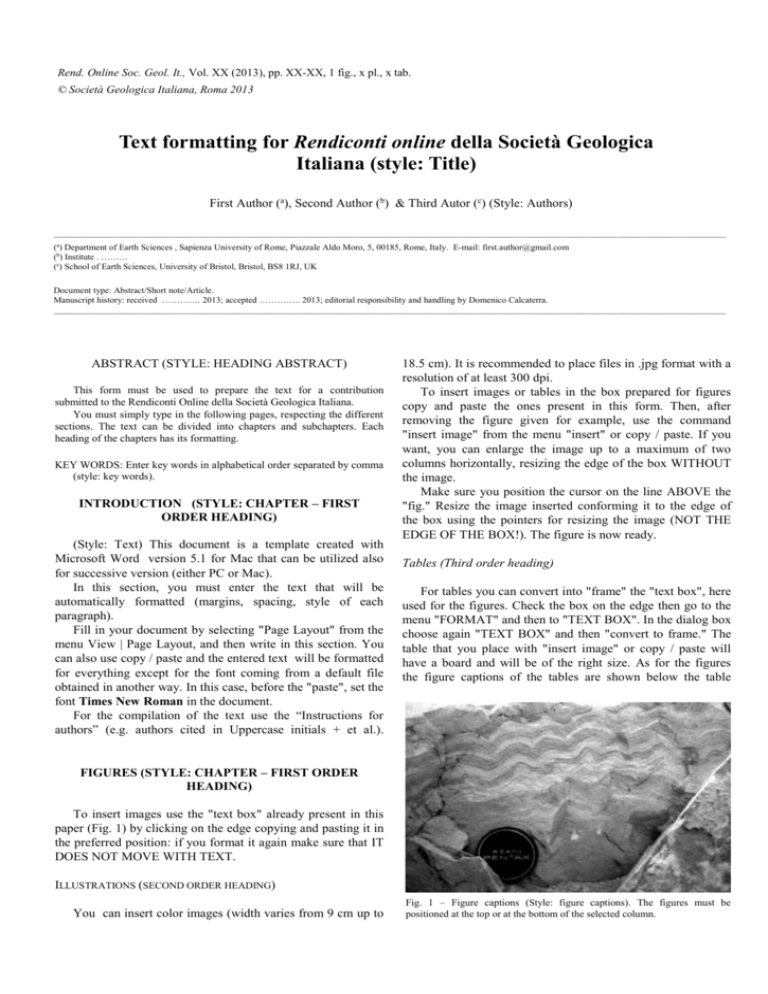
Rend. Online Soc. Geol. It., Vol. XX (2013), pp. XX-XX, 1 fig., x pl., x tab. © Società Geologica Italiana, Roma 2013 Text formatting for Rendiconti online della Società Geologica Italiana (style: Title) First Author (a), Second Author (b) & Third Autor (c) (Style: Authors) _____________________________________________________________________________________________________________________________________________________ (a) Department of Earth Sciences , Sapienza University of Rome, Piazzale Aldo Moro, 5, 00185, Rome, Italy. E-mail: first.author@gmail.com (b) Institute . ……… (c) School of Earth Sciences, University of Bristol, Bristol, BS8 1RJ, UK Document type: Abstract/Short note/Article. Manuscript history: received …………. 2013; accepted ………….. 2013; editorial responsibility and handling by Domenico Calcaterra. _____________________________________________________________________________________________________________________________________________________ ABSTRACT (STYLE: HEADING ABSTRACT) This form must be used to prepare the text for a contribution submitted to the Rendiconti Online della Società Geologica Italiana. You must simply type in the following pages, respecting the different sections. The text can be divided into chapters and subchapters. Each heading of the chapters has its formatting. KEY WORDS: Enter key words in alphabetical order separated by comma (style: key words). INTRODUCTION (STYLE: CHAPTER – FIRST ORDER HEADING) (Style: Text) This document is a template created with Microsoft Word version 5.1 for Mac that can be utilized also for successive version (either PC or Mac). In this section, you must enter the text that will be automatically formatted (margins, spacing, style of each paragraph). Fill in your document by selecting "Page Layout" from the menu View | Page Layout, and then write in this section. You can also use copy / paste and the entered text will be formatted for everything except for the font coming from a default file obtained in another way. In this case, before the "paste", set the font Times New Roman in the document. For the compilation of the text use the “Instructions for authors” (e.g. authors cited in Uppercase initials + et al.). 18.5 cm). It is recommended to place files in .jpg format with a resolution of at least 300 dpi. To insert images or tables in the box prepared for figures copy and paste the ones present in this form. Then, after removing the figure given for example, use the command "insert image" from the menu "insert" or copy / paste. If you want, you can enlarge the image up to a maximum of two columns horizontally, resizing the edge of the box WITHOUT the image. Make sure you position the cursor on the line ABOVE the "fig." Resize the image inserted conforming it to the edge of the box using the pointers for resizing the image (NOT THE EDGE OF THE BOX!). The figure is now ready. Tables (Third order heading) For tables you can convert into "frame" the "text box", here used for the figures. Check the box on the edge then go to the menu "FORMAT" and then to "TEXT BOX". In the dialog box choose again "TEXT BOX" and then "convert to frame." The table that you place with "insert image" or copy / paste will have a board and will be of the right size. As for the figures the figure captions of the tables are shown below the table FIGURES (STYLE: CHAPTER – FIRST ORDER HEADING) To insert images use the "text box" already present in this paper (Fig. 1) by clicking on the edge copying and pasting it in the preferred position: if you format it again make sure that IT DOES NOT MOVE WITH TEXT. ILLUSTRATIONS (SECOND ORDER HEADING) You can insert color images (width varies from 9 cm up to Fig. 1 – Figure captions (Style: figure captions). The figures must be positioned at the top or at the bottom of the selected column. 2 FIRST AUTHOR ET AL. (STYLE: HEADING EVEN PAGES) itself preceded by Table 1 and justified. MANUSCRIPT SUBMISSION Manuscripts must be sent to the Organizing Committee of the 12th EGN Conference to the following e-mail address: info@egnconference2013.cilentoediano.it EXAMPLE OF CONTRIBUTION ABSTRACT In the Southern Apennines and Calabria outcrop metamorphic slices of hercynian and/or alpine age. The reconstructions by Glauco Bonardi and co-authors of an alpine subduction-related origin for the emplacement of those rocks is still supported by a number of tectonic and geodynamic constraints. Alps and Apennines are two end members of opposite subduction zones (i.e., “E”-ward and “W”-ward), having different depth and evolution of the accretionary prism basal decollement. The PTt evolution of the metamorphic rocks of Calabria can be better reconciled with an earlier alpine-type evolution, where the continental and oceanic slices of crust have been subducted and re-exhumed by the deepening of the decollement planes into both the upper and lower plates and accreting the orogen. The early alpine emplacement of those metamorphic rocks is testified by their high structural elevation, the HP/LT assemblages and by stratigraphic constraints (e.g., Bonardi et al., 2005). Therefore it can be interpreted that the earlier alpine subduction was gradually substituted by the opposite W-directed Apennines subduction, having in its hangingwall the boudinated relics of the alpine history. KEY WORDS: Alps, Apennines, crystalline basement, subduction. INTRODUCTION Glauco Bonardi was not only a great geologist, but also a fine gentleman and a good friend (Fig. 1). We had a number of discussions on the tectonic evolution of the Southern Apennines and the Calabrian arc. One of the statements that I cannot forget is his aristotelian view of science, particularly when referring to any geodynamic model of the Apennines: “prima mostra e poi dimostra”, i.e., “first show, and then demonstrate”, or in other words “first show the data, then you can make a model based on those data”. The issue we were trying to face is the existence or not of an “alpine” core in the Apennines. There are a number of models depicting the Southern Apennines and Calabria, including their internal metamorphic thrust sheets, as a fold and thrust belt generated by the Apennines subduction alone, without an earlier subduction zone directed toward the opposite direction (e.g., Knott, 1987; Rossetti et al., 2001). Alternatively, since historical papers such as Amodio Morelli et al. (1976), until Bonardi et al. (2005), the metamorphic slices outcropping in Calabria and Peloritani mountains have been attributed to an earlier alpine phase, followed by the later apenninic history (Alvarez et al., 1974). Amodio Morelli et al. (1976) interpreted the metamorphic slices of ophiolites and basement rocks in Calabria as correlatable to the Pennidic and Austroalpine units of the Western Alps. Bonardi et al. (2005) suggested that the lower Miocene Paludi Formation seals the European vergent alpine thrusts, whereas it is involved by the Africa (Adriatic)-vergent Apennines thrusts. A number of papers updated the PTt and structural history of those metamorphic and magmatic slices (Caggianelli et al., 1991; 1999; Cello et al., 1996; Graessner et al., 2001; Rossetti et al., 2001; Liberi et al., 2006; Heymes et al., 2010; Langone et al., 2010; Appel et al., 2011) overlying the sedimentary cover (Bonardi et al., 1994; Iannace et al., 2007; Parente et al., 2007). The motion of the subduction hinge toward or away relative to a fixed upper plate has been shown to be the simple kinematic indicator of the occurrence of two different subduction styles (Doglioni et al., 2007). When the subduction hinge converges toward the upper plate, the upper plate is shortened and a double vergent belt, such as the Alps, forms. On the contrary when the slab and the related hinge retreat relative to the upper plate, the upper plate is stretched (and a backarc basin opens), and a single vergent belt develops, such as the in the Apennines-Tyrrhenian Sea system. Alpine relics are boudinated in the hangingwall of the Apennines, stretched by the Tyrrhenian backarc rifting (Doglioni et al., 1998). Relative to the upper plate, the subduction hinge moved toward it in the Alps (or alpine-type belts), allowing deep thrusts involving both upper and lower plates, with prograde and retrograde metamorphism. In the Apennines, the subduction hinge migrated away with respect to the upper plate (from late Eocene to Present, Carminati et al., 2010; 2012). Therefore, in the Apennines there is not an upper plate actively converging with respect to the lower plate, although the transition between the two opposite subduction systems may have lasted about 20 Ma, from the late Eocene to the early Miocene. The Apennines kinematics and depth of the decollement atop the lower plate precludes the possibility to involve deep slices of the basement and the thrusting of both plate margins. GEOLOGICAL SETTING The Alps and the Apennines (Beltrando et al., 2010, and references therein) are associated to two opposite subductions, which inverted the Permo-Mesozoic tethyan passive continental margins bordering segments of southern Europe, the Adriatic plate, northern Africa and possibly an intevening microplate (Doglioni, 1992; Guerrera et al., 1993). The Alps are related to the subduction of Europe ”eastwardsoutheastward” underneath the Adriatic plate (Panza & Mueller, 1978; Dal Piaz et al., 2003; Dal Piaz, 2010; Brandmayr et al., 2011), whereas the Apennines were generated by the “westward” subduction of the Adriatic-Ionian lithosphere (Scandone, 1980; Malinverno & Ryan, 1986; Doglioni, 1991; Doglioni et al., 1999; Scrocca et al., 2005; Chiarabba et al., 2008). In spite of a similar background, Alps and Apennines have very different geologic signatures and represent two end members of orogens related to subduction zones (Fig. 2). In synthesis, the following characters can be recognised in Alps and Apennines respectively: 1) Subduction hinge converging TITLE OF THE CONTRIBUTION (STYLE: HEADING ODD PAGES) 3 Fig. 2 – The two end-members of subduction zones show distinct PTt evolution. The metamorphic rocks outcropping in Calabria and internal Apennines are interpreted as related to the Alpine type evolution, which implies deeper decollement planes, affecting both the upper (U) and the lower (L) plates. In the Alpine type to the left, the subduction hinge (H) converges relative to the upper plate, whereas it diverges in the Apennines type to the right. The Apennines type section in reality has the lower plate presently diverging relative to the upper plate. Moreover, according to the model presented, the Apennines contains the boudinated relicts of the earlier Alpine orogen. The Apennines subduction should have developed along the retrobelt of the Alpine belt. and diverging relative to the upper plate; 2) Double vs. single vergence; 3) High vs. low morphological and structural elevation; 4) Deep vs. shallow rocks involved; 5) The occurrence of higher metamorphic degree vs. lower metamorphic degree; 6) The basal décollement involves the crust and the LID of both upper and lower plates whereas only the shallow crust of the lower plate contributes to the accretionary prism; in the Apennines, the upper plate was not structured as a contractional retrobelt (as a consequence the term collision should be abandoned), but it was stretched and dismemberd to form the backarc basin; 7) Alpine shallow vs. apenninic deep foredeep; 8) Low vs. high dip of the foreland monocline; 9) Thickened crust all over the alpine belt, whereas it is thinner in the western side of the Apennines; 10) The Alps have both in the upper and in the lower plate a pre-subduction Moho, whereas the Apennines have in the footwall plate a presubduction Moho, but in the hangingwall they have a new forming Moho; 11) Thickened lithosphere vs. a shallow asthenosphere in the hangingwall; 12) No vs. well developed backarc basin and related alkaline-tholeiitic magmatism; 13) Scarce vs. larger abundance of subduction-related volcanism; 14) Smooth vs. high amplitude gravity and heath flow anomalies (Carminati & Doglioni, 2012). The differences between the two belts seem to be sensitive to the geographic polarity of the subduction. In the hangingwall of the Apennines subduction there occurs the boudinated and stretched relict of the former double verging Alps, and only more externally in the central-eastern side the real Apennines accretionary prism was developed. The Apennines nucleated along the retrobelt of the Alps, where there was oceanic or thinned continental lithosphere to be consumed. Corsica thrust sheets The thrust sheets in northeast Corsica are usually attributed to the Alps, due to their similarity with the Schists Lustrés with meta-ophiolites cropping out in the Alps. The main emplacement of those rocks occurred during the Eocene, well before the Oligo-Miocene opening of the backarc Provençal Basin. Therefore, once restored the Early Miocene counterclockwise rotation of the Corsica-Sardinia microplate, the Corsica thrust-sheets match the Maritime Alps. In addition, 4 FIRST AUTHOR ET AL. (STYLE: HEADING EVEN PAGES) the Alps front can be connected to the Betics front (southern Spain) through the Balearic promontory. For these reasons Alps, Alpine Corsica and the Betics can be reasonably considered to be part of the same belt (Doglioni et al., 1997; 1998; Carminati et al., 2010). The Alps and similar contractional belts are double vergent and are typically 200-250 km wide. According to this constraint, the front of the alpine retrobelt associated with the Corsica front should have been at least 200 km more to the east. The alpine thrust sheets outcropping in Corsica can be followed in the western Tyrrhenian Sea both in seismic lines and dredging. The metamorphic basement slices outcropping in Tuscany, Calabria, and northeast Sicily could be interpreted as relicts of that inherited orogen (e.g., Bonardi et al., 1994). Alpine relicts, stretched and collapsed by the backarc extension can be recognized in the Tyrrhenian basin (see sections by Elter & Pandeli, 1990; Mauffret et al., 1999; Pascucci et al., 1999; Sartori, 2005). Also magmatism supports the occurrence of an alpine metasomatized mantle within the Apennines (Peccerillo, 2005). Along their southern prolongation, the Alps were probably still active (late Oligocene-early Miocene) while the Apennines subduction initiated. This could explain the coexistence of early Miocene HP/LT metamorphism (Alpine type) in the Tuscan archipelago synchronous with western Sardinia calcalkaline magmatism and foredeep subsidence suggesting the started activity of the Apennines subduction. Similarly, in the Southern Apennines-Calabria, the transition between the ealier Alpine subduction to the Apennines flip may have persisted until the early Miocene (Bonardi et al., 2005). ACKNOWLEDGMENTS I thank the organizing committee of the meeting to honorate Glauco, a geologist who deeply contributed to the advancement of geology in Italy. I also want to remember his wife Paola De Capoa who always assisted Glauco, sharing his kindness, geological skill, and widespread culture. REFERENCES Alvarez W., Cocozza T. & Wezel F.C. (1974) - Fragmentation of the Alpine orogenic belt by microplate dispersal. Nature, 248, 309-314. Amodio Morelli L., Bonardi G., Colonna V., DietrichD., Giunta G., Ippolito F., Liguori V., Lorenzoni S., Paglionico A., Perrone V., Piccarreta G., Russo M., Scandone P., Zanettin Lorenzoni E. & Zuppetta A. (1976) - L'arco calabro-peloritano nell'orogene Appenninico-Maghrebide. Mem. Soc. Geol. It, 17, 1-60. Appel P., Cirrincione R., Fiannacca P. & Pezzino A. (2011) Age constraints on Late Paleozoic evolution of continental crust from electron microprobe dating of monazite in the Peloritani Mountains (southern Italy): another example of resetting of monazite ages in high-grade rocks. Int. J. Earth Sci. (Geol Rundsch), 100, 107-123. Beltrando M., Peccerillo A., Mattei M., Conticelli S. & Doglioni C. (2010) - The Geology of Italy: tectonics and life along plate margins. J. Virtual Explorer ISSN 14418142, 36. Bonardi G., De Capoa P., Fioretti B. & Perrone V. (1994) Some remarks on the Calabria-Peloritani arc and its relationship with the Southern Apennines. Boll. Geof. Teor. Appl. 36, 483-492. Bonardi G., De Capoa P., Di Staso A., Perrone V., Sonnino M. & Tramontana M. (2005) - The age of the Paludi Formation: a major constraint to the beginning of the Apulia-verging orogenic transport in the northern sector of the Calabria–Peloritani Arc. Terra Nova, 17, 4, 331-337. Brandmayr E., Marson I., Romanelli F. & Panza G.F. (2011) Lithosphere density model in Italy: no hint for slab pull. Terra Nova, doi: 10.1111/j.1365-3121.2011.01012.x Caggianelli A., Del Moro A., Paglionico A., Piccarreta G., Pinarelli L. & Rottura A. (1991) - Lower crustal granite genesis connected with chemical fractionation in the continental crust of Calabria (Southern Italy). European Journal of Mineralogy, 3, 159-180. Caggianelli A., Prosser G. & Del Moro A. (1999) - Cooling and exhumation history of deep-seated and shallow level, late Hercynian granitoids from Calabria. Geol. J., 24, 22-31. Carminati E., Lustrino M., Cuffaro M. & Doglioni C. (2010) Tectonics, magmatism and geodynamics of Italy: What we know and what we imagine. In: (Eds.) Marco Beltrando, Angelo Peccerillo, Massimo Mattei, Sandro Conticelli, and Carlo Doglioni, The Geology of Italy: tectonics and life along plate margins, Journal of the Virtual Explorer, Electronic Edition, ISSN 1441-8142, volume 36, paper 9, doi:10.3809/jvirtex.2010.00226 Carminati E. & Doglioni C. (2012) - Alps Vs Apennines: The paradigm of a tectonically asymmetric Earth. Earth Science Rev., in press. Carminati E., Lustrino M. & Doglioni C. (2012) - Geodynamic evolution of the central and western Mediterranean: Tectonics vs. igneous petrology constraints. Tectonophysics, doi:10.1016/j.tecto.2012.01. 026 Cello G., Invernizzi C. & Mazzoli S. (1996) - Structural signature of tectonic processes in the Calabrian Arc, southern Italy: Evidence from oceanic-derived DiamanteTerranova unit. Tectonics 15, 187–200. Chiarabba C., De Gori P. & Speranza F. (2008) - The southern Tyrrhenian subduction zone: Deep geometry, magmatism and Plio-Pleistocene evolution. Earth Planet. Sci. Lett., 268, 408-423. Dal Piaz G.V., Bistacchi A. & Massironi M. (2003) Geological outline of the Alps. Episodes, 26, 175-180. Dal Piaz G.V. (2010) - The Italian Alps: a journey across two centuries of Alpine geology. J. Virtual Explorer, 36, ISSN 1441-8142. Doglioni C. (1991) - A proposal for the kinematic modelling of W-dipping subductions; possible applications to the Tyrrhenian-Apennines system. Terra Nova, 3, 423-434. Doglioni C. (1992) - Main differences between thrust belts. Terra Nova, 4, 152-164. TITLE OF THE CONTRIBUTION (STYLE: HEADING ODD PAGES) Doglioni C., Gueguen E., Sabat F. & Fernandez M. (1997) The western Mediterranean extensional basins and the Alpine orogen. Terra Nova, 9, 109-112. Doglioni C., Mongelli F. & Pialli G.P. (1998) - Boudinage of the Alpine belt in the Apenninic back-arc. Mem. Soc. Geol. It., 52, 457-468. Doglioni C., Merlini S. & Cantarella G. (1999) - Foredeep geometries at the front of the Apennines in the Ionian sea (central Mediterranean). Earth Planet. Sci. Lett., 168, 243-254. Doglioni C., Carminati E., Cuffaro M. & Scrocca D. (2007) Subduction kinematics and dynamic constraints. Earth Sci. Rev., 83, 125-175. Elter M. & Pandeli E. (1990) - Alpine and Hercynian orogenic phases in the basement rocks of the Northern Apennines Larderello geothermal field, Southern Tuscany, Italy. Eclogae. Geol. Helv., 83, 241-264. Graessner T., Schenk V., Broecker M. & Mezger K. (2001) Geochronological constraints on the timing of granitoid magmatism, metamorphism and post-metamorphic cooling in the Hercynian crustal cross-section of Calabria. J. Metamorphic Geol., 18, 409-421. Guerrera F., Martin-Algarra A. & Perrone V. (1993) - Late Oligocene–Miocene syn- late-orogenic successions in Western and Central Mediterranean Chains from the Betic Cordillera to the Southern Apennines. Terra Nova, 5, 525-44. Heymes T., Monie P., Arnaud N., Pecher A., Bouillin J-P. & Compagnoni R. (2010) - Alpine tectonics in the CalabrianPeloritan belt (southern Italy): New 40Ar/39Ar data in the Aspromonte Massif area. Lithos, 114, 451-472. Iannace A., Vitale S., D'errico M., Mazzoli S., Di Staso A., Macaione E., Messina A., Reddy S.M., Somma R., Zamparelli V., Zattin M. & Bonardi G. (2007) - The carbonate tectonic units of northern Calabria (Italy): a record of Apulian palaeomargin evolution and Miocene convergence, continental crust subduction, and exhumation of HP-LT rocks. J. Geol. Soc. London, 164, 1165-1186. Knott S.D. (1987) - The Liguride Complex of southern Italy – a Cretaceous to Paleogene accretionary wedge. Tectonophysics, 142, 217–26. Langone A., Godard G., Prosser G., Caggianelli A., Rottura A. & Tiepolo M. (2010) - PTt path of the Hercynian lowpressure rocks from the Mandatoriccio complex (Sila Massif, Calabria, Italy): new insights for crustal evolution. Journal of Metamorphic Geology, 28, 137-162. 5 Liberi F., Morten L. & Piluso E. (2006) - Geodynamic significance of ophiolites within the Calabrian Arc. Island Arc, 15, 26–43. Malinverno A. & Ryan W.B.F. (1986) - Extension in the Tyrrhenian Sea and shortening in the Apennines as result of arc migration driven by sinking of the lithosphere. Tectonics, 5, 227-245. Mauffret A., Contrucci I. & Brunet C. (1999) - Structural evolution of the Northern Tyrrhenian Sea from new seismic data. Marine and Petroleum Geology, 16, 381-407, DOI: 10.1016/S0264-8172(99)00004-5. Panza G.F. & Mueller S. (1978) - The plate boundary between Eurasia and Africa in the Alpine area. Mem. Ist. Geol. Mineral. Univ. Padova, 33, 43-50. Parente M., Frijia G. & Di Lucia M. (2007) - Carbon-isotope stratigraphy of Cenomanian-Turonian platform carbonates from southern Apennines (Italy): a chemostratigraphic approach to the problem of correlation between shallowwater and deep-water successions. Journal of the Geological Society, London, 164, 609-620. Pascucci V., Merlini S. & Martini I.P. (1999) - Seismic Stratigraphy of the Miocene-Pleistocene Sedimentary Basins of the Northern Tyrrhenian Sea and Western Tuscany (Italy). Basin Research, 11, 337-356. Peccerillo A. (2005) - Plio-Quaternary volcanism in Italy. Petrology, geochemistry, geodynamics. Springer, Heidelberg, 365 pp. Rossetti F., Faccenna C., Goffé B., Monié P., Argentieri A., Funiciello R. & Mattei M. (2001) - Alpine structural and metamorphic signature of the Sila Piccola Massif nappe stack (Calabria, Italy): Insights for the tectonic evolution of the Calabrian Arc. Tectonics, 20(1), 112–133, doi:10.1029/2000TC900027. Sartori R. (2005) - Bedrock geology of the Tyrrhenian Sea insight on Alpine paleogeography and magmatic evolution of the basin. In: Crop Project: Deep Seismic Exploration of the Central Mediterranean and italy. Finetti I.R. (Ed.). Elsevier Science, The Netherlands, Atlases in Geoscience 1, 69-80. Scandone P. (1980) - Origin of the Tyrrhenian Sea and Calabrian Arc. Boll. Soc. Geol. It., 98, 27-34. Scrocca D., Carminati E. & Doglioni C. (2005) - Deep structure of the Southern Apennines, Italy: Thick skinned or thick-skinned? Tectonics, 24, doi:10.1029/2004TC001634.


